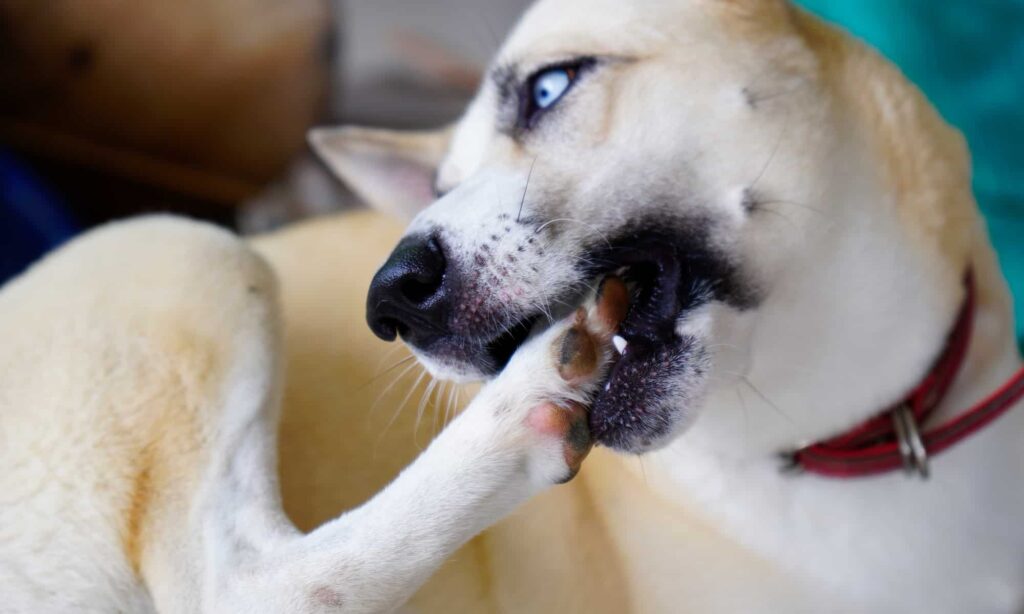Why is my dog attacking its own legs?

Witnessing your beloved dog attacking its own legs can be both confusing and concerning. This behavior, known as “self-mutilation” or “self-directed aggression”, can manifest in various ways, from biting and chewing to scratching and licking.
Self-directed aggression in dogs is a complex behavior that can have multiple underlying causes. It’s crucial to differentiate between occasional scratching or grooming, which is normal behavior, and persistent, excessive self-directed aggression. The latter can be a sign of an underlying medical or behavioral issue that requires attention.
Itch, Irritation or Pain
One common reason a dog may attack its own legs is due to itchiness or irritation. Dogs may exhibit this behavior when they have itchy skin or experience discomfort due to allergies, insect bites, skin conditions, or external irritants. Dogs might gnaw or bite at their legs in an attempt to alleviate the discomfort.
Conditions such as allergies, skin infections and parasites (like fleas or mites) can cause discomfort or itching, prompting your dog to attack its own legs. A thorough examination by a veterinarian can help identify and treat any medical issues contributing to the behavior.
Behavioral Issues
Beyond medical issues, this behavior can also stem from psychological or behavioral factors. Boredom, anxiety, stress, and compulsive disorders can all lead to this type of behavior. Dogs that are left alone for long periods without mental or physical stimulation can become bored and may resort to self-directed aggression as a way to relieve their anxiety or stress.
Some dogs might display compulsive or self-directed behavior, leading them to attack their own legs. Dr. Karen Overall, a veterinary behaviorist, mentions that compulsive behavior can manifest in dogs due to stress, anxiety, boredom, or frustration, leading to repetitive actions like attacking their legs.
Allergic Reactions
Allergic reactions, especially to insect bites or stings, might prompt a dog to attack its own legs. Dr. Ernest Ward, a veterinarian, explains that allergic reactions to insect bites, such as fleas or mosquitoes, could cause intense itching and discomfort, leading a dog to chew or attack the affected areas.
Neurological Conditions
In some cases, dogs might exhibit self-directed behavior due to underlying neurological conditions. Certain neurological disorders could lead to abnormal sensations in a dog’s legs, prompting the dog to attack them as a response to those abnormal sensations.
Conditions such as peripheral neuropathy or degenerative myelopathy can cause nerve damage, leading to sensations of tingling or discomfort in the legs. Dogs may respond to these sensations by attacking their own legs in an attempt to relieve the discomfort.
Addressing the Behaviour
Once any underlying medical conditions have been addressed, it’s essential to focus on managing the behavioral aspects of self-directed aggression. Here are some strategies to consider:
- Provide Mental and Physical Stimulation: Regular exercise and mental stimulation through interactive play and puzzle toys can help keep your dog’s mind and body engaged, reducing boredom and anxiety.
- Establish a Routine: Dogs thrive on routine, so establishing a consistent daily schedule for feeding, exercise, and playtime can help reduce stress and anxiety.
- Consider Medication: In some cases, medication may be necessary to manage underlying anxiety or compulsive disorders. Consult with a veterinarian or veterinary behaviorist to discuss the best course of action for your dog.
- Behavioral Modification: Working with a professional dog trainer or behaviorist can help address any underlying behavioral issues contributing to self-directed aggression. They can provide guidance on positive reinforcement techniques and behavior modification exercises.
Self-directed aggression behavior in dogs can be distressing for both the dog and the owner. By understanding the potential causes of this behavior and taking proactive steps to address them, you can help your dog live a happier and healthier life. Remember, it’s essential to work closely with your veterinarian and, if necessary, a professional dog trainer or behaviorist to develop a comprehensive plan to manage and address the behavior.










